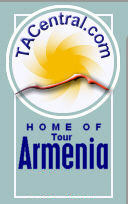|
THE ECONOMY IN ARMENIA
Armenia used to be the richest republic of the USSR. That was then. This is now.
Tour Armenia
Updated 2026
In short:
Since the collapse of the USSR in December 1991 and the ongoing conflict with Azerbaijan over Nagorno-Karabakh, Armenia has been in a severe economic decline with small percentages of growth in select sectors, mainly restricted to Yerevan. Under the old Soviet central planning system, Armenia had developed a significant industrial sector, supplying machine tools, textiles, and other manufactured goods to other republics in exchange for raw materials and energy.
Since 1991, Armenia has also switched to small-scale farming away from the behemoth agricultural complexes of the Soviet era. The agricultural sector has long-term needs for more investment and updated technology.
The privatization of industry has been at a slower pace, and seems rife with corruption. Strategic interests such as Armenia's phone sector and electric generation plants, have been sold to Greek and Russian interests, respectively. Armenia is a food importer, and its mineral deposits (copper, gold, bauxite) are small.
By 1994, however, the Armenian Government had launched an ambitious IMF-sponsored economic program that has resulted in positive growth rates in 1995-2003. Armenia also has managed to slash inflation, stabilize the local currency (the dram), and privatize most small- and medium-sized enterprises.
The service sector and small enterprises constitute the bulk of Armenia's growing economy.
The Banking System
The Tax System
Before
Uncharted Territory
Current Economic Situation
Foreign Trade
Potential
Generations
______________________________________________
Tabular Data - Economy of Armenia
| GDP : |
purchasing power parity - $12.6 billion (2002 est.) |
| GDP - Real Growth Rate : |
12.7% (2002 est.) |
| GDP - Per Capita : |
purchasing power parity - $3,800 (2002 est.) |
| GDP - Composition By Sector : |
agriculture: 30%
industry: 26%
services: 44% (2001 est.) |
| Population Below Poverty Line : |
50% (2002 est.) |
| Household Income or Consumption by Percentage : |
lowest 10%: 2.3%
highest 10%: 46.2% (1996) |
| Inflation Rate (Consumer Prices) : |
1.1% (2002 est.) |
| Labor Force : |
1.4 million (2001) |
| Labor Force - By Occupation : |
agriculture 45%, services 30%, industry 25% (2002 est.) |
| Budget : |
revenues: $402 million
expenditures: $482 million, including capital expenditures of $NA (2003 est.) |
| Industries : |
metal-cutting machine tools, forging-pressing machines, electric motors, tires, knitted wear, hosiery, shoes, silk fabric, chemicals, trucks, instruments, microelectronics, gem cutting, jewelry manufacturing, software development, food processing, brandy |
| Industrial Production Growth Rate : |
15% (2002 est.) |
| Electricity - Production : |
6.479 billion kWh (2001) |
| Electricity - Production by Source : |
fossil fuel: 42.3%
hydro: 27%
nuclear: 30.7%
other: 0% (2001) |
| Electricity - Consumption : |
5.784 billion kWh (2001) |
| Electricity - Exports : |
704 million kWh; note - exports an unknown quantity to Georgia; includes exports to Nagorno-Karabakh region in Azerbaijan (2001) |
| Electricity - Imports : |
463 million kWh; note - imports an unknown quantity from Iran (2001) |
| Agriculture - Products : |
fruit (especially grapes), vegetables; livestock |
| Exports : |
$525 million f.o.b. (2001 est.) |
| Exports - Commodities : |
diamonds, mineral products, foodstuffs, energy |
| Exports - Partners : |
Russia 17.7%, US 15.2%, Belgium 13.6%, Israel 9.7% (2001) |
| Imports : |
$991 million f.o.b. (2001 est.) |
| Imports - Commodities : |
natural gas, petroleum, tobacco products, foodstuffs, diamonds |
| Imports - Partners : |
Russia 19.5%, UK 10.4%, US 9.6%, Iran 8.9%, Belgium (2001) |
| Debt - External : |
$905 million (June 2001) |
| Economic Aid - Recipient : |
ODA $170 million (2000) |
| Currency : |
dram (AMD) |
| Currency Code : |
AMD |
| Exchange Rates : |
drams per US dollar - NA (2002), 555.078 (2001), 539.526 (2000), 535.062 (1999), 504.915 (1998) |
| Fiscal Year : |
calendar year |
Interfax: Armenia
Three Views of the Armenian Economy
Issues of Bankruptcy in Armenia
American Chamber of Commerce in Armenia
Armenia's Economy: World Bank Report
Brandt Report
ArmInfo Economic Report
BSEC (Black Sea Economic Cooperation Business Council) Site
Armenian Embassy: Business and Economy
 Top
Top
 Back
Back

|



